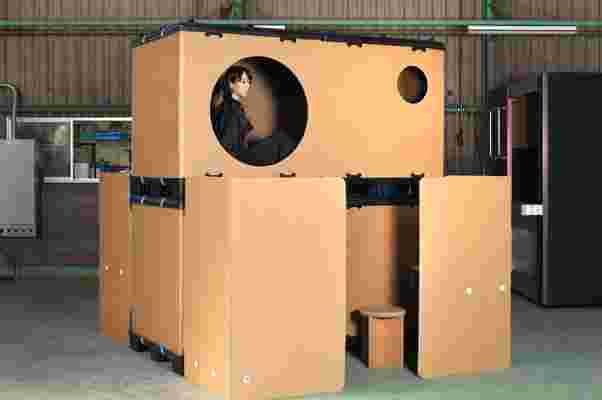
Following a year filled with unprecedented, back-to-back global emergencies , designers and architects have responded with their own safety measures and shelter-in-place structures. Design office Atelier OPA based in Tokyo recently debuted their own emergency shelter system. Inspired by the work of Japanese master architect Kisho Kurokawa, Atelier OPA developed a two-story foldable emergency shelter called Cardboard Sleep Capsule modeled after the Japanese Metabolism movement.
The Cardboard Sleep Capsule was designed for those experiencing displacement from natural disasters like earthquakes or medical emergencies, including those related to the COVID-19 pandemic. Atelier OPA constructed the Cardboard Sleep Capsule to unfold into two floors, containing two sleeping areas, a set of stairs, and a separate working space equipped with a desk and chair. The capsule shelter comes prefabricated with a foldable design, comprising a compact shipping size when folded, shrinking down to ¼ the size of its unfolded dimensions. Carrying such a small folded size, the Cardboard Sleep Capsule has been received positively by international governments, who have thought of storing the cardboard castles away before use in public gymnasiums and emergency arenas.
Easy and quick assembly is crucial for emergency shelters considering the short amount of time we do have when seeking refuge. Built with reinforced cardboard walls and high-density polyethylene flooring, the facades and corners of the Cardboard Sleep Capsule are fastened with sliding locks, requiring no tools or hardware for assembly. The two sleeping areas are stacked on top of one another, complete with circular entrances and windows for natural ventilation and sunlight. While the bottom bunk is accessible from the ground floor, cardboard stairs bring individuals to the top bunk for easy entry. Considering the private working spaces and bunk beds, the Cardboard Castle provides 3.5m2 of living space per person.
Designer: Atelier OPA
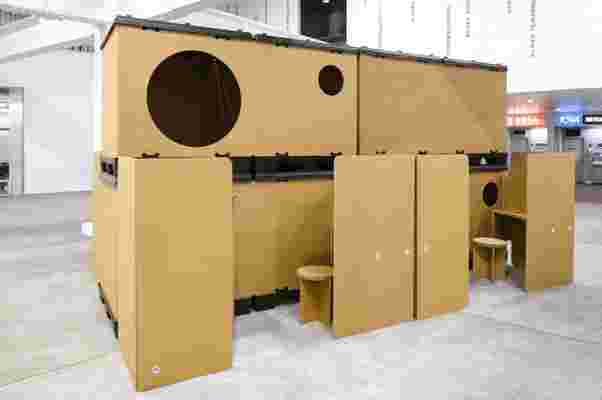
Two Cardboard Sleep Capsules can be joined together to form emergency shelter communities.
The bedroom spaces are large enough to comfortably fit one person and are built with pressure-resistant materials for ensured safety and stability.
Right next door to each sleeping area, Atelier OPA integrated a private working space complete with a desk and chair.
The barrier in front of each private working space partially conceals the bedrooms’ entryways.
Organic concrete curves give an unconventional vibe to this sustainable luxury home
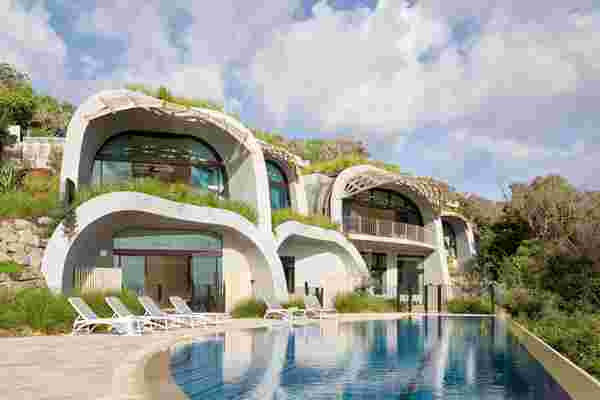
When I first saw the Domik house, it felt like someone brought a kid’s illustration to life in the most aesthetically pleasing way possible! Nestled into the sandhills south of Noosa National Park, Australia, this private residence is playful retention of modern architecture. It’s curves make it positively stand out (as curves always do!) and every crevice by Noel Robinson Architects is just giving us house goals!
Designed for a client who wanted a timeless and practical holiday home, I imagine he is truly enjoying his quarantine overlooking the Pacific Ocean because that is where I would be living out the pandemic if I had the option. The eco-home has 3 floors, 6 bedrooms, 9 bathrooms, and is one of Australia’s most expensive homes. The exterior is anything but that of a conventional house – it has several large domes stacked upon each other and covered with green roofs to blend in with nature. The unusual shape and use of natural materials truly optimize the natural sunlight and ventilation that Domik gets due to its premium location. It almost looks like the house is wearing a hooded cloak of eco-consciousness.
It was clear to the design team that sustainability was a very important aspect of the house – no air conditioning was to be installed and renewable energy should be used to generate power on-site along with using sustainable construction materials. So that is why the Domik house features an expansive rooftop solar array supported by a battery storage system. The design also incorporates the collection of roof water to be reused on-site. The internal non-loadbearing walls are made with hempcrete for thermal insulation (and acoustics!). Hempcrete has high carbon sequestration and is a fully recyclable product.
The sculptural forms were designed to give it an organic appeal and not destroy the landscape the house was in by using an angular build. The concrete arches were a smart move because they minimized the need for internal columns, made way for high ceilings, and maximized the space for spanning windows. The floor + footprint area of the property is massive and the landscape continues from the ground to the top using lightweight timber ‘eyelids’ to form the concrete arches. The residence is camouflaged into the natural setting seamlessly with the fluid shapes and gardened roofs. Quarantine or not, a getaway home has 3 cores – entertainment, sports, and health which is exactly what the team delivered with their eco-friendly and visually appealing design plan. Huge but still cozy!
Designer: Noel Robinson Architects
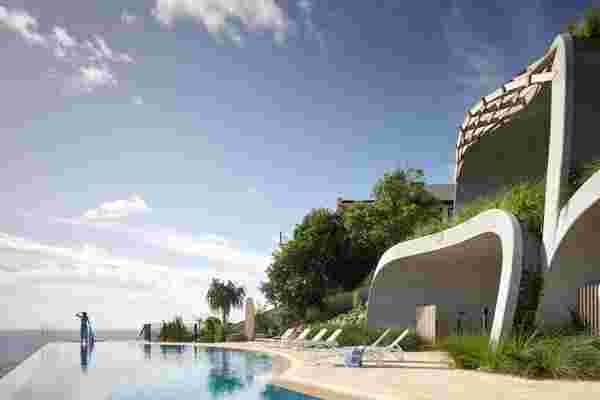
This migrating collection of pods plans to clean the floating islands of plastic in our oceans
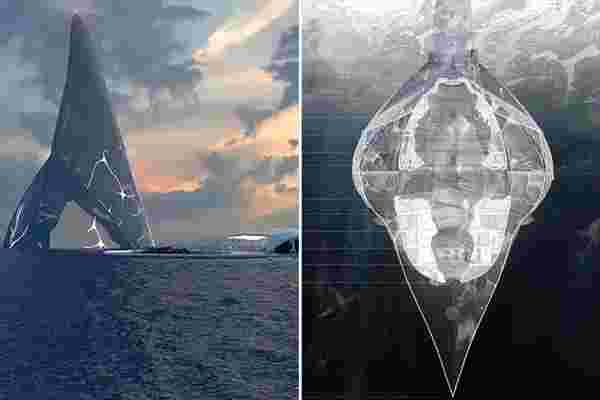
While the world handles the COVID-19 crisis, we haven’t forgotten the climate crisis . Designers Lucy Zakharova and Ted Lu have proposed a plan to tackle the ocean pollution problem with a network of five capsules that will work towards restoring the marine ecosystem’s health. The revolutionary project has been rightfully named ‘En·cap·su·lat·ing’! Let’s dive in.
There is actually so much trash in the ocean that we have a designated area called the Great Pacific Garbage Patch. The patch is 1.6 million square kilometers large and these capsules will be built from the plastic waste found here. There are literal islands made of plastic and marine life is forced to either eat plastic or get entangled in it which has been adversely affecting the larger food chain as well as migration – the marine ecosystem is being tested harshly and if not acted upon right now, it could collapse. Each capsule will be deployed at a different depth level in the ocean and work for that zone so the load is divided equally between all five structures. The real revolution here is that each pod of this constellation is non-static or migrating in design, so the pod can move along with the floating islands of plastic.
The capsules will have a non-static infrastructure and move cyclically in their ocean zones. They are not only there to mitigate the crisis caused by humans but also help the animals have a healthier environment. The main goal of this project is to detoxify the ocean by changing the plastic configuration and spread more awareness of its long-term toxic effects. The structures will have dedicated areas for research labs and data collection about the deep sea. Teams will monitor temperature, pressure, salinity, and working on preserving marine life that has not been able to adapt to the climatic changes. Structures like these are crucial for us to understand the weight of our actions and do our best to fix the damage so that we don’t have to deal with another crisis – 2021 can be a good year if we try!
Designers: Lucy Zakharova and Ted Lu
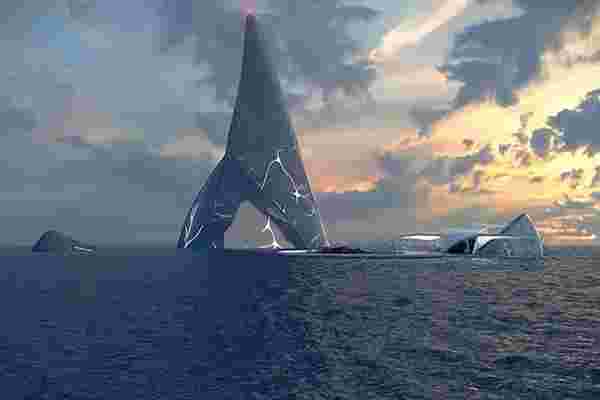
The conceptual designs of the facility
Drone view of the facility.
Top view of the floating structure.
Underwater view of the facility.
The underwater sectional view of the facility.
The underwater view showcasing the three different facilities: education, research, and environmental preservation.
The flattened map of the Earth showing the plastic islands floating in the oceans.
The concentration of the plastic trash in the Atlantic Ocean, the Indian Ocean and the Pacific Ocean
Sketch/ exploration of the environmental preservation station








